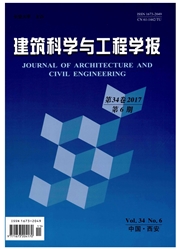

 中文摘要:
中文摘要:
为更好掌握开口肋加劲板的设计计算方法,采用弹性稳定分析方法,对无纵向和横向加劲肋的四边简支板、纵向加劲肋等间距布置的四边简支加劲板、纵向和横向加劲肋等间距布置的加劲板进行屈曲模态和临界屈曲应力分析。结果表明:对于四边简支板或四边简支加劲板,临界屈曲应力与板宽、板长和板厚均有关,减小板宽和板长以及增大板厚可提高临界屈曲应力;随着加劲肋刚度比的变化,四边简支加劲板一般表现出3种屈曲模态,模态1为加劲肋与被加劲板共同发生整体屈曲,模态2为在加劲肋处形成波节,加劲肋与被加劲板发生屈曲,模态3为加劲肋为刚性加劲肋,不会发生失稳,只有被加劲板发生局部失稳;临界屈曲应力随加劲肋刚度比的增大而增大,模态1增大幅度最大,模态2次之,模态3逐步趋于定值。
 英文摘要:
英文摘要:
In order to master the design and calculation method of open-rib stiffened plate better, the buckling modes and critical buckling stress of four-side simply-supported plate without longitudinal and transverse stiffening ribs, four-side simply-supported stiffened plate with longitudinal stiffening ribs arranged by equal distance, stiffened plate with longitudinal and transverse stiffening ribs arranged by equal distance, were analyzed by elastic stability theory. The results show that critical buckling stress is related to plate width, plate length and plate thickness for four-side simply-supported plate or four-side simply-supported stiffened plate. Critical buckling stress can be improved with the decrease of plate width and plate length, and with the increase of thickness of plate. There are 3 kinds of buckling modes of four-side simply- supported stiffened plate with changes of stiffness ratios of stiffening ribs. Stiffening ribs and stiffened plate are overall buckling in mode 1. Wave nodes are formed on stiffening ribs, stiffening ribs and stiffened plate are buckling in mode 2. Stiffening ribs will not appear instable, only stiffened plate is buckling in mode 3. Critical buckling stress increases with the increase of stiffness ratio of the stiffening rib, the increase range is maximal in mode 1, and comes second in mode 2. Critical buckling stress tends to be constant value in mode 3.
 同期刊论文项目
同期刊论文项目
 同项目期刊论文
同项目期刊论文
 期刊信息
期刊信息
